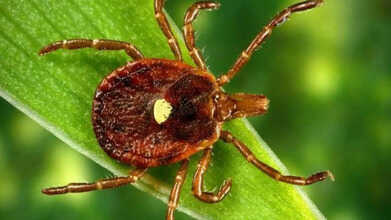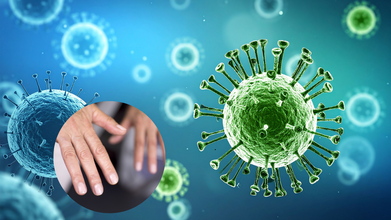- Health Conditions A-Z
- Health & Wellness
- Nutrition
- Fitness
- Health News
- Ayurveda
- Videos
- Medicine A-Z
- Parenting
Alpha Gal Syndrome: First Death Linked To Tick-Borne Meat Allergy Alarms Health Experts; Know The Warning Signs

Credits: CDC
Alpha gal: The first recorded death linked to alpha-gal syndrome, a dangerous allergy to red meat that can develop after a tick bite, has been confirmed. UVA Health shared on Thursday that the victim was a 47-year-old man from New Jersey who had enjoyed good health until a family camping trip in the summer of 2024.
One evening, he and his family ate steak around 10 p.m. A few hours later, at about 2 a.m., he woke with sharp stomach pain, vomiting, and diarrhea. By morning he felt stable again, and told his son, “I thought I was going to die.” Two weeks later, after eating a hamburger at a barbecue around 3 p.m., he fell sick again.
He went to the bathroom at 7:20 p.m. His son found him on the floor ten minutes later, unconscious and surrounded by vomit. Emergency services were called while the son attempted CPR.
Paramedics continued trying to revive him for nearly two hours as he was taken to the hospital, but he was pronounced dead at 10:22 p.m. An autopsy showed no major issues with his heart, brain, lungs, or abdomen, and the medical examiner recorded the case as “sudden unexplained death.”
When Platts-Mills and the UVA Health team tested a blood sample, they discovered the man had become highly sensitive to alpha-gal. The results showed a reaction pattern similar to what is seen in fatal anaphylaxis, a severe allergic response marked by breathing trouble and widespread hives.
What Is Alpha Gal Syndrome?
Alpha-gal syndrome (AGS) is a meat allergy that develops after bites from certain ticks, most often the lone star tick. People with AGS react to mammalian meat such as beef, pork, or lamb, and sometimes to other products made from mammals.
Symptoms do not appear right away. They usually surface between two and six hours after eating foods that contain alpha-gal. Doctors diagnose AGS by reviewing symptoms, checking IgE antibody levels, and seeing whether a patient improves after avoiding mammalian meat. Treatment focuses on steering clear of foods and items that contain alpha-gal and reducing the risk of future tick bites, according to the Mayo Clinic.
Alpha Gal Syndrome: First Death Linked To Tick-Borne Meat Allergy
Platts-Mills learned from the man’s wife that her husband had been bitten 12 or 13 times by tiny mites called chiggers that summer. After looking more closely, the doctor realised that many of those bites were actually from young lone star ticks. The Independent reported that Platts-Mills and his team believe a beer the man drank on the day he died, along with ragweed pollen exposure, may have intensified his reaction.
Alpha Gal Syndrome: What Is Leading To Alpha Gal Syndrome?
Although lone star ticks were once thought to be the only source of alpha-gal sensitisation, researchers have now found that two more species can trigger the condition. Deer ticks and western black-legged ticks have also been linked to AGS. Tick activity rises during warmer months, placing people in much of the eastern United States at greater risk.
Scientists think that when a tick bites, it may introduce the alpha-gal sugar molecule into the bloodstream, which can set off changes in the immune system. After that, eating beef, pork, lamb, or other mammalian products can cause a delayed allergic reaction.
Alpha Gal Syndrome: Early Warning Symptoms
Early signs of AGS may include hives, itching, stomach cramps, nausea, vomiting, diarrhea, or general abdominal discomfort, usually beginning two to six hours after eating red meat or dairy.
Some people may also develop wheezing, trouble breathing, light-headedness, or a dangerous reaction known as anaphylaxis. Anyone who experiences severe symptoms such as breathing difficulty or a sudden fall in blood pressure should get medical help right away.
About 110,000 possible cases were recorded in the United States between 2010 and 2022, though experts believe the real number may be higher. Because symptoms appear long after a meal, many people go undiagnosed or struggle to connect their reactions to the foods they ate.
What Is Behind The Rise In Whooping Cough Cases Across The United States?

Credits: Canva
Multiple states across the United States have reported a rise in whooping cough this year. On Nov. 3, the Texas Department of State Health Services released a notice describing a “significant increase” in cases, with 3,500 infections reported from January through October 2025.
This figure is four times higher than the number seen during the same period in 2024. Two days later, on November 5, the Mississippi State Department of Health announced that whooping cough cases have “dramatically increased,” reaching 130 so far this year.
What Is Whooping Cough?
Whooping cough, also known as pertussis, is a highly contagious respiratory infection caused by the bacterium Bordetella pertussis. It usually begins with symptoms similar to a simple cold but can progress to intense coughing spells that create a “whooping” sound when a person breathes in, as per Cleveland Clinic.
These coughing fits can lead to vomiting or short pauses in breathing, especially in babies. The illness is particularly dangerous for infants, although routine vaccination offers strong protection for people of all ages.
Whooping Cough Symptoms
Whooping cough develops in stages. The incubation period, which is the time between exposure and the first symptoms, can range from five to 21 days. The illness progresses through three stages.
The first resembles a mild cold, with tiredness, low fever, coughing, sore throat, watery eyes, and nasal congestion. The second stage can last from one to ten weeks and is known for severe coughing fits called paroxysms, vomiting, and the well-known “whoop” that follows a coughing spell. Cleveland Clinic notes that recovery forms the third stage, which can last up to six weeks.
Symptoms may shift as a person moves through the phases.
- Initial stage (1 to 2 weeks): Symptoms mirror a common cold, including a runny nose, sneezing, light cough, and low-grade fever.
- Paroxysmal stage (after 1 to 2 weeks): The cough becomes harsher and arrives in bursts. Breathing in after a fit can create a high-pitched “whoop.” In this stage, some people may experience:
- Vomiting after coughing spells
- Blue or purple skin due to low oxygen
- Short pauses in breathing (apnea), especially in infants
- Recovery stage: Coughing fits begin to ease but may linger for several weeks or months.
Whooping Cough: Why Are Whooping Cough Cases Increasing In the US?
Experts link this rise to dropping vaccination rates, especially among children, which makes it easier for the infection to spread. Specialists warn that vaccination is the strongest tool to keep numbers under control. They also point out that whooping cough often increases in cycles every few years, and the illness cannot be fully eliminated.
“We practitioners and public health professionals are concerned because we are seeing a year-after-year trend of a significant increase in cases when this is preventable,” said Hector Ocaranza, a pediatrician and member of the Texas Medical Association’s Council on Science and Health Promotion, as per Texas Tribune. “Especially a disease that can have such a severe effect on infants, older people, and those who have chronic conditions.”
The agency’s latest alert, issued on November 3, also mentioned that more than half of last year’s cases appeared in November and December, suggesting that numbers may keep rising.
Whooping Cough: Who Are More Vulnerable?
Babies younger than six months face the highest risk because they have not yet completed their vaccination schedule. One in three infants with whooping cough needs hospital care, and one in five may develop pneumonia. Some babies experience seizures or swelling in the brain. Many infants do not cough but instead gag or turn blue or purple due to long pauses in breathing that may last more than 20 seconds, a condition known as life-threatening apnea.
Healthy teenagers and adults can also catch the infection and may develop pneumonia, along with coughing fits that cause vomiting, exhaustion, and sometimes rib fractures. However, the chance of death is much lower in older children and adults. If treated early, antibiotics can ease symptoms and limit the spread of the illness.
The Texas health department notes that vaccination remains the strongest form of protection and urges parents to ensure that children are current on their pertussis shots.
5-Step Protection Plan Against Delhi's Toxic Air, According To Doctor

Credits: Canva
Another day when Delhi again woke up to thick layer of smog, with the city's average AQI at 414. The PM2.5 levels are at 395.47, PM10 at 363.7, and the air quality falls under 'Hazardous'.
Amid all this, even the Supreme Court has directed advocates to choose virtual hearings over appearing in person in courts. While Delhi continues to battle with toxic fog, doctors are calling it a public health emergency, and urging people to follow measures to keep themselves safe. One such set of measures are given by Dr Ashok Seth, Padma Bhushan Awardee and Chairman of Fortis Escorts Heart Institute, as reported by PTI. Dr Seth suggests five essential steps for people to reduce the damage from the toxic air.
Five-Step Protection From Delhi's Toxic Air
Limit Going Outdoors
The PM 2.5 concentration in Delhi is 53.6 times the World Health Organization (WHO)'s annual PM2.5 guideline value. This pollutant is so small that it can enter from one's blood into the blood stream and could cause damage to every organ, points out Dr Sandeep Nayar, Principal Director and HOD, Chest and Respiratory Diseases at BLK Max Super Specialty Hospital in Delhi. To be safe from these pollutants, Dr Seth suggests to limit outdoor exposure.
“Step one: go out as little as possible. And if you absolutely must step out, do so only with an N95 mask, the same kind we all used during COVID. These masks significantly reduce the intake of PM2.5 particles.”
Get Vaccinated
Dr Seth says that elderly, heart patient, and other vulnerable people, who may have any comorbidities must get vaccinated against pneumonia and common viral infections. "If you are elderly, a heart patient, or otherwise vulnerable, make sure you’re vaccinated against pneumonia and common viral infections. Chest infections rise tremendously during this season, and vaccination offers vital protection," he notes.
Do Not Go For Your Morning Walks Or Exercise
"Avoid exercising outdoors entirely," says Dr Seth. "Whether it’s cycling, using a static bike, or doing yoga, keep all your workouts indoors for now.”
Use An Air Purifier
Dr Seth suggests that keeping an air purifier could help you breathe cleaner air. "If it is within your means, keep at least one air purifier at home so the air you breathe indoors is cleaner and safer.”
Indoor Plants
"Grow green plants inside your home. Plants naturally help purify the air and increase oxygen levels," suggests Dr Seth. In fact, a NASA study also notes that certain plants could help improve indoor air quality. These plants with the help of their leaves and roots remove trace levels of toxic vapors from inside sealed buildings, notes the study.
Some of these plants that improve indoor air quality include:
- Snake Plant
- Spider Plant
- Peace Lily
- English Ivy
- Areca Palm
Lastly, Dr Seth reminds that eating the right food, and maintaining a balanced diet is utmost important to build one's immunity against pollution. As he says, "Most importantly, stay positive, eat healthy, drink plenty of water, and build your immunity, these small habits go a long way during heavily polluted months.”
We All Could Carry The Epstein-Barr Virus That Triggers Lupus, According To Stanford Scientists

Credits: Canva
A new study published in the Science Translational Medicine has revealed a connection between the virus called the pstein-Barr virus (EBV), a pathogen silently carried by almost 95% of adults with systemic lupus rythematosus, better known as lupus.
This Stanford-led research shows that EBV could highjack a tiny subset of immune cells and push the body into a full-blown autoimmune attack. It uses ultraprecise sequencing technique to do so, which scientists have finally been able to tract down in the infected immune cells and have been able to uncover how just a handful of them could lead to widespread inflammation. As per the researchers, the mechanism could explained virtually all lupus cases.
Why Lupus Has Been So Hard to Explain
Lupus impact is severe as it affects hundred thousand Americans, and has an estimate of 5 million people being affected with this worldwide. It is a chronic autoimmune disorder in which the immune system mistakenly attacks the nuclei of the body's own cells, and leads to damage across organs. These organs include anywhere from skin, joints, to heart, kidneys, and even the nervous system.
A reason that continues to remain mysterious is why 90% of lupus patients are women. While medications can slow the disease and help most people live normal lives, the condition can be life-threatening for about 5% of patients. Despite decades of research, scientists have struggled to pinpoint a single trigger. EBV has always been a suspect, but until now, no one had the tools to prove it.
You May Have The Virus That Triggers Lupus
Despite the devastating truth about lupus, almost everyone has EBV, the virus that could trigger it. It is so common that even one researcher joked that the only way to avoid is be living "in a bubble".
How does it spread? EBV usually spreads through saliva, by sharing utensils as kids, or kissing. It can cause mononucleosis, the classic “kissing disease,” which often leaves people with lingering fatigue.
What makes this tricky is that once EBV infects you, it never fully leaves. It is like herpes or chickenpox viruses, which could tuck its genetic material into the nuclei of infected cells and lies dormant, sometimes, throughout life. Among its favorite hiding spots are B cells, powerful immune cells responsible for producing antibodies and activating other parts of the immune system.
Typically, only a tiny fraction of someone’s B cells carry EBV, making them nearly impossible to detect with older scientific tools.
What Does This Breakthrough May Mean For Finding These EBV Inside Rogue B Cells?
Using their new high-precision sequencing method, the Stanford team discovered that in a healthy person, fewer than 1 in 10,000 B cells carry EBV. But in patients with lupus, the ratio jumps dramatically to 1 in 400—a 25-fold increase.
This matters because EBV-infected B cells occasionally produce an important viral protein called EBNA2. EBNA2 behaves like a genetic on-switch. It activates dormant human genes, many of which are involved in inflammation. Once switched on, these B cells turn into aggressive, hyper-inflammatory antigen-presenting cells. They, in turn, rally other immune cells, especially helper T cells, to join the attack.
Those T cells then recruit hundreds of other B cells that mistakenly target the nuclei of healthy cells. The result? A runaway chain reaction that leads to the formation of antinuclear antibodies, the hallmark of lupus.
Critically, most of the B cells joining the attack are not EBV-infected. But once the inflammatory cascade begins, EBV need not be present in every cell. It only needs a few instigators.
Do Everyone With EBV Get Lupus?
While nearly all of us has EBV, only some people develop autoimmune diseases. This could be because certain EBV strains may be more likely to convert B cells into the 'driver cells' that would kick-start autoimmunity. Genetics too plays an important role in how someone's immune system responds to these infected cells.
This new finding therefore just does not offers a broader understanding of lupus, but also opens doors for treatment strategies. Many biotech companies are already developing EBV vaccines, though these would need to be given in early infancy because vaccines cannot clear an existing infection.
There’s also interest in aggressive therapies like ultradeep B-cell depletion, which aims to wipe out all circulating B cells and allow new, EBV-free cells to grow back.
Researchers say the same EBV-triggered mechanism may play a role in other autoimmune conditions, including multiple sclerosis, rheumatoid arthritis, and Crohn’s disease.
© 2024 Bennett, Coleman & Company Limited

